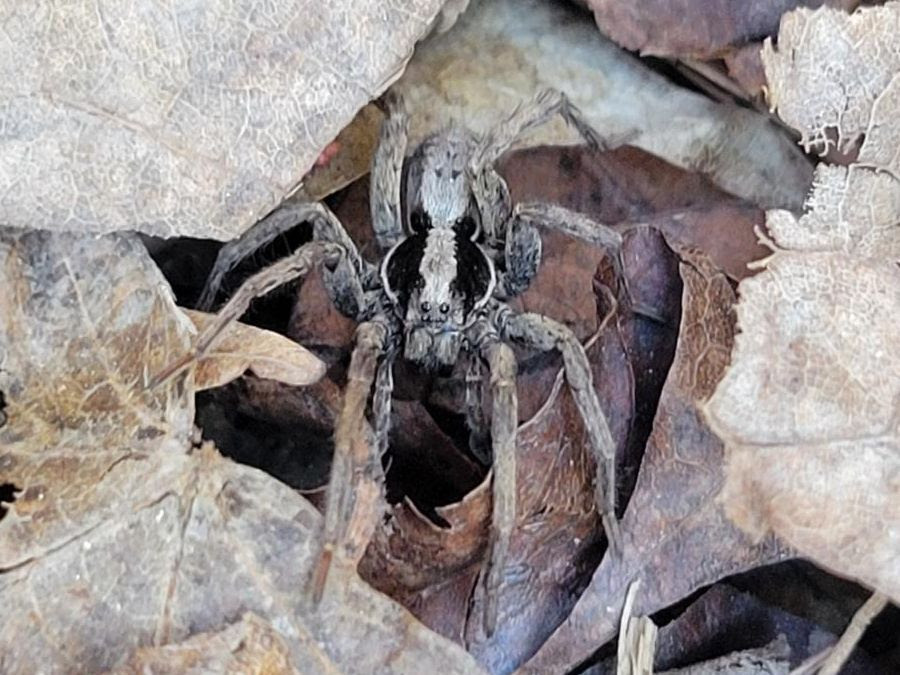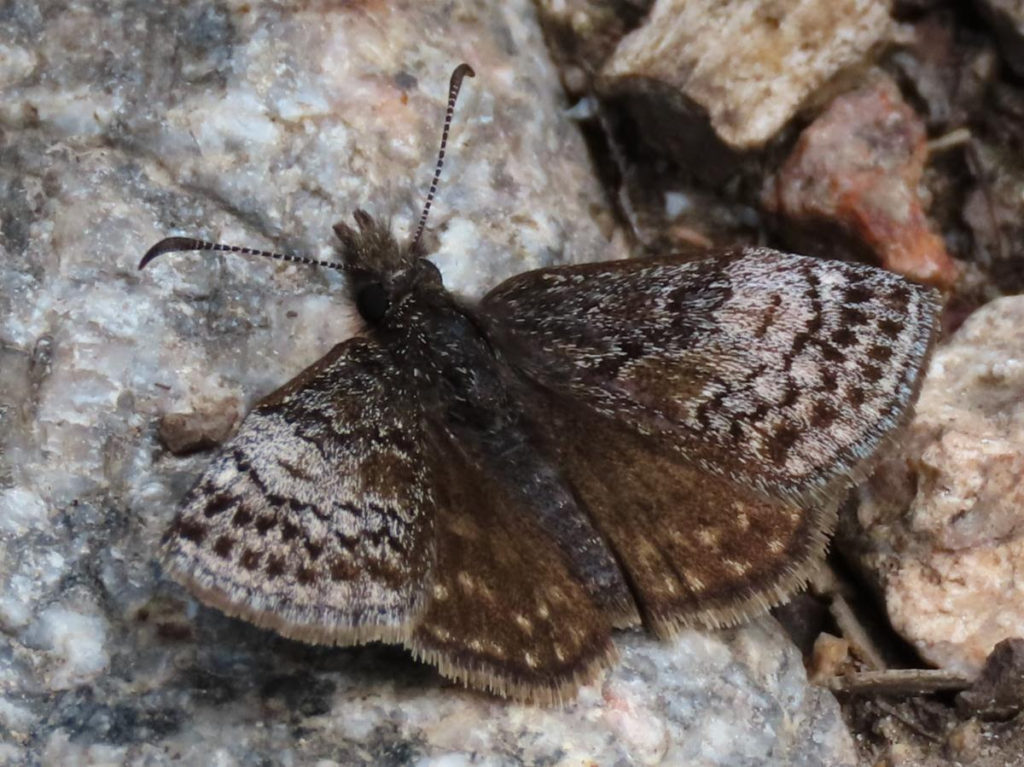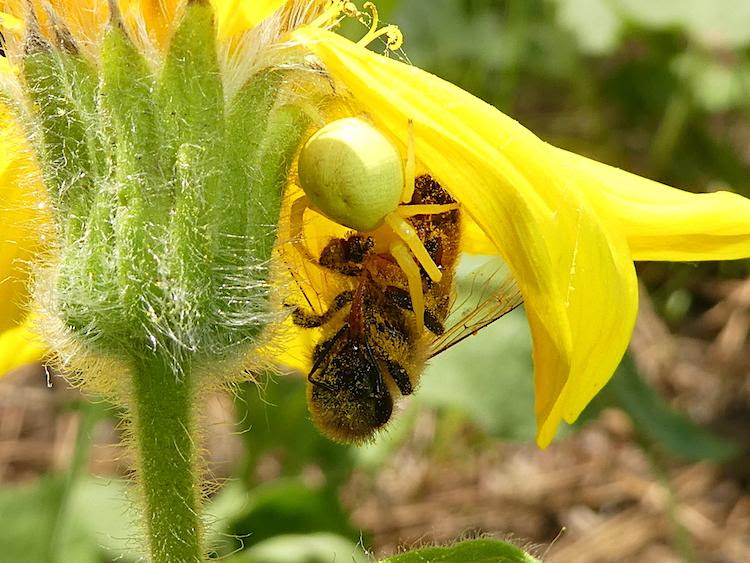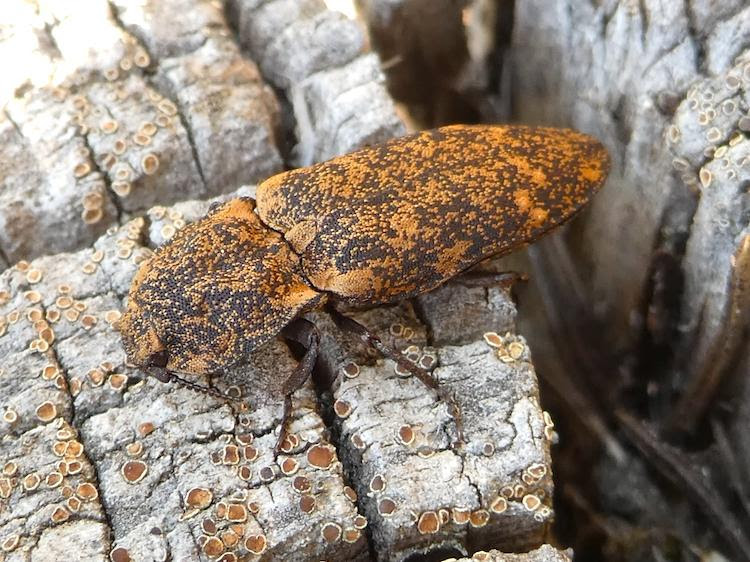This week, we’re starting to see signs of insects that didn’t overwinter in their adult stage like skipper butterflies and bee flies, as well as some late bloomers like the Nevada bumblebee, usually the last of the bumblebee queens to emerge from hibernation. Spring is in full swing, and just in time: we only have a few more weeks until summer, after all.

Early Tachinid Fly
Epalpus signifer
Tachinid flies, a family of true flies with over 8,000 described species are parasites and parasitoids of other arthropods. Adult flies will lay their eggs on or in a preferred host; some species will lay their eggs on the host species’ food source. Like many parasitoid wasps, only the tachinid fly larvae feed of their hosts, while adults prefer flower nectar or “honeydew,” a sugary aphid secretion. E. signifer is a widespread species, found throughout North America.
Kelly Dix, May 10th, 2023. Lake Como, Bitterroot Valley, MT.
Striped Sweat Bee
Agapostemon sp.
Striped sweat bees are named for their distinctive striped abdomens, but are also known as “metallic sweat bees” for their blue or green metallic head and thorax. All 44 species in this genus (ranging from southern Canada to northern Argentina) nest in the ground; while they may nest close together – even sharing the same burrow entrance – these bees do not form colonies or divide their labor. Agapostemon females mate in late summer/early fall and overwinter in the ground. In the spring, she will emerge to dig and furnish her brood cells.
Glenn Marangelo, May 18th, 2023. Missoula, MT.


Forest Wolf Spider
Hogna frondicola
Some of the largest spiders encountered in Montana are wolf spiders (family Lycosidae). Most are ground-dwelling and nocturnal. Their long legs and unparalleled eyesight allow them to ambush their meal—no web needed. Some dig burrows in the ground; others make holes under rocks, and many have no retreat at all. Forest Wolf Spiders can generally be identified by a wide gray stripe down the center of the carapace (hard upper “shell” of the cephalothorax) and white on the edges. They range from the Yukon Territory to Newfoundland, south to California and Alabama.
Morgan McNeill, May 14th, 2023. Lolo, MT.
Two-banded Checkered Skipper
Pyrgus ruralis
The two-banded checkered skipper is a western species of butterfly, flying from southwest Alberta to southern California, where an endangered subspecies resides in the mountains east of San Diego. When they are ready to pupate, the caterpillars fold themselves into a leaf cocoon. They will seal the edges closed with a silken thread, turning themselves into the literal definition of “snug as a bug in a rug.” Unlike many early spring butterflies (who overwinter as adults and emerge to mate and lay eggs in the spring), we only see one generation of skipper each year, usually from April to July.
Kelly Dix, May 10th, 2023. Lake Como, Bitterroot Valley, MT.


Brown Elfin
Callophrys augustinus
These small butterflies can be found in western Montana from May to mid-June in a variety of habitats, including mixed conifer/deciduous woodlands and bogs. Almost any place where acidic soils predominate, and their larval plants, mainly in the Heath Family (Ericaceae), thrive. (The Common Huckleberry is one example.) The olive green to yellow green caterpillars feed on flowers, fruits, and leaves of the host plants. Brown Elfins often fly in the company of others and enjoy sipping nectar, as well as moisture from wet sand and earth. They range across much of North America, but are absent from the Midwest.
Kelly Dix, May 12th, 2023. Kootenai Creek, Selway-Bitterroot Wilderness, MT.
Greater Bee Fly
Bombylius major
It’s easy to see where the greater bee fly gets its name. This widespread fuzzy fly is easily mistaken for a bumblebee as it darts from flower to flower, collecting nectar. Greater bee flies are spectacular aviators, exhibiting a unique flight technique known as “yawing.” Yawing allows the fly to rotate on a vertical axis, making their movements unpredictable and difficult to track. Adult female flies lay their eggs near the entrance of ground-nesting bee burrows. When the larvae hatch, they will take over the burrow, feeding on food stores and the bee larva itself. When the fly larvae have had their fill, they pupate inside the nesting chamber. Adults emerge in early spring, and are usually seen from March – May.
Stephen Decker, May 18th, 2023. Rattlesnake Creek, Missoula, MT.


Six Spotted Orbweaver
Araniella displicata
The six spotted orbweaver may be the original itsy bitsy spider. The largest females rarely measure over 7mm in length, with their legspan maxing out at 17mm. Like the majority of spider species, the males are even smaller. Unlike many female orbweavers, who are mature and gravid in the fall, A. displicata lays her eggs in early summer. Many orbweaver species die off, leaving their eggs to overwinter in their egg cases, but by fall, the six spotted orbweaver eggs have already hatched. The spiderlings overwinter in their juvenile stage, seeking a warm retreat to shelter themselves from the harsh winter conditions.
Kelly Dix, May 14th, 2023. Mill Creek Trail, Selway-Bitterroot Wilderness, MT.
Rocky Mountain Parnassian
Parnassius smintheus
Parnassians are part of the swallowtail family (Papilionidae), but don’t look like the typical bold, black and yellow or white-winged ones. They lack tails and are mostly white, with black and red markings. Rocky Mountain Parnassians have alternating black and white rings on their antennae, and wings that are mostly white, with both wings usually sporting red spots, along with gray to black spots. They can be found from the mountains of California, Utah, and New Mexico north into the southern Yukon. The butterflies lay eggs on species of stonecrop plants (shown next to this caterpillar), which their offspring will eat in the spring after overwintering as an egg.
Kathleen Ort, May 21st, 2023. Mt. Baldy, Sapphire Mountains, MT.


Dreamy Duskywing
Erynnis icelus
Like the aforementioned two-banded checkered skipper, the dreamy duskywing is another skipper butterfly that takes wing from April-July. This species is widespread, found across the United States and north into Canada, although northern species tend to be smaller than their US counterparts. Like many skipper species, the caterpillars form a leaf shelter to overwinter in, emerging in the early spring to pupate.
Kelly Dix, May 14th, 2023. Mill Creek Trail, Selway-Bitterroot Wilderness, MT.
Nevada Bumblebee Queen
Bombus nevadensis
If the bumblebees you’ve seen lately seem a little larger-than-life, it’s because the queens are waking up from their underground winter slumber and emerging to feed. Despite the name, the Nevada bumblebee is found throughout the western United States, and typically emerges later than other bumblebee species. Once the queen finds a suitable place to establish her colony – usually underground – she will start producing workers. Bumblebee colonies are annual; by late fall, the only remaining individuals are the new queens, who will dig a suitable hibernaculum to wait out the winter.
Glenn Marangelo, May 23rd, 2023. Missoula, MT.


Goldenrod Crab Spider
Misumena vatia
Goldenrod Crab spiders are masters at blending in. These spiders can change their color over several days (ranging from yellow to white) in order to better blend in with their environment. You most often find them patiently “sitting and waiting” amongst flowers for an unsuspecting bee, fly, or other pollinator to become their next meal. This individual has managed to snag an unwitting bee, nearly twice her own size.
Glenn Marangelo, May 20th, 2023. Missoula, MT.
Western Sculpted Pine Borer
Chalcophora angulicollis
The only western species in the genus Chalcophora, the western sculpted pine borer is so named for the “sculpted” look of the elytra and thorax. As a member of the metallic wood-boring beetle family, it doesn’t comes across as “metallic” at first; but once she lifts her elytra (wing covers) for takeoff, the striking blue and purple iridescence of the abdomen is revealed. If one is flying nearby, you’ll likely hear it before you see it. These large beetles are conspicuously (and sometimes alarmingly) loud aviators.
Glenn Marangelo, May 20th, 2023. Missoula, MT.


Silvery Blue
Glaucopsyche lygdamus
The Silvery Blue is on the wing from May into mid June and has prominent rows of black spots circled in white on each wing. It can potentially be confused for the Boisduval’s Blue, but the Silvery’s spots tend to be “neater” than those on the Boisduval’s and they tend to lack additional spots toward the inside of the wings (close to the body). In the west, the Silvery Blue ranges from central Alaska to southern California. In the east, it can be found from Nova Scotia to Georgia.
Glenn Marangelo, May 20th, 2023. Missoula, MT.
Short Horned Click Beetle
Danosoma brevicorne
Click beetles are everywhere, but you’d never know if you weren’t looking for them. These miniscule beetles often go unnoticed in favor of larger, more charismatic insects. But spend some time looking for them, and you’ll be rewarded for your efforts. Gently pick up any click beetle (family Elateridae) and you’ll not only hear the clicking sound they make, you’ll see your little friend launch into the air. They use this “click” to hopefully avoid being eaten and occasionally to right themselves in case they end up on their back.
Glenn Marangelo, May 20th, 2023. Missoula, MT.
